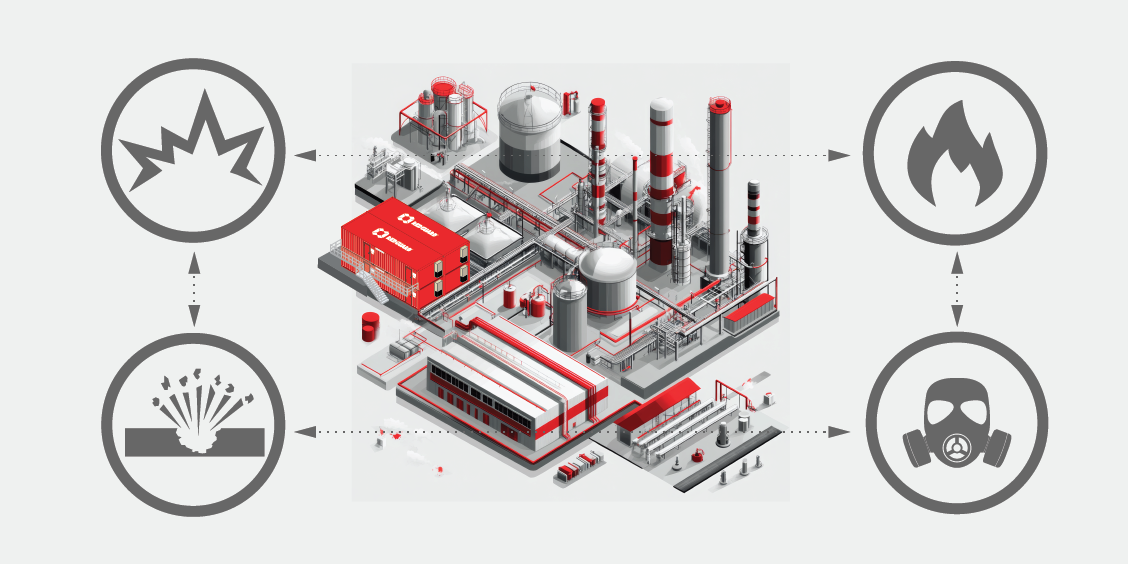What is Multi-Hazard? What is a Multi-Hazard Building?


In the heart of a processing plant, the air is thick with potential danger. Picture this: a routine day is suddenly shattered by an unexpected blast. The explosion ignites nearby materials, which results in a raging fire. Toxic gases are released into the air, and deadly fragments fly in every direction. This is a terrifying possibility in multi-hazard environments in the oil and gas industry, where the danger of blasts, fires, toxic gas releases, and fragmentation (or any combination of these) are risks that some hazardous areas face.
The good news is that with planning, incidents are less likely, and catastrophes can be prevented. Plants measure risk by conducting facility siting studies or quantitative risk assessments every five years as part of their process hazard analysis. Once facility managers are aware of the risks, specialty modular buildings can be placed on these sites to save lives and protect assets. It’s all covered in the American Petroleum Institute’s recommended practices. In this case, under API RP 752 and API RP 753.
What is Multi-Hazard? What is a Multi-Hazard Resistant Building?
You may have heard term multi-hazard and have heard about multi-hazard buildings. Multi-hazard can be defined as multiple individual hazards that affect a specific region and the interrelationships of the hazards themselves. As the example illustrated, one danger sets off a chain reaction of events. A multi-hazard incident can have more severe consequences.
What are Multi-Hazard Buildings?
Multi-hazard buildings offer protection against several hazards at once. In areas with multiple risks, multi-hazard resistant designs are invaluable. Some of the hazards that multi-hazard buildings offer protection from are the risk of toxic gas release, explosions (blasts), fragmentation, storms and fires.
Though we often refer to them as blast-resistant buildings, it is important to know that RedGuard buildings have never been singularly focused on only one hazard. Sure, we talk a lot about blasts and blast testing, and it is very important, but RedGuard steel blast resistant buildings are also inherently resistant to things like fragmentation and flash fires; other protections for risks like toxic gas release, pool fires or jet fires can be added when needed.
Fire Protection in Steel Blast Resistant Buildings
Fire protection is important and by their very nature, steel blast resistant buildings are a source of protection from flash fires which are often associated with explosions. Flash fires occur when a flammable substance (like dust particles, flammable liquids, or a flammable gas) is mixed with air and comes into contact with an ignition source. A flash fire is characterized by high temperature, short duration, and a rapidly moving flame front.
A pool fire occurs when a flammable liquid leaks, forms a reservoir and the pool of liquid is ignited. Potentially more dangerous is the jet fire, which occurs when a flammable gas or liquid escapes under pressure and is ignited. RedGuard employs a combination of insulation and wall assemblies to protect against pool and jet fires. In areas with the highest hazard risks, usually areas that handle highly flammable hydrocarbons, intumescent coatings can also be used. Adding these high-performance protections ensures that RedGuard buildings have an extra layer of safety and that their occupants remain protected despite extreme thermal threats.
Toxic Gas Protection in Steel Blast Resistant Buildings
If toxic gas releases are a risk, other protections, such as specialized HVAC systems, ventilation and blowdown stacks, can be added.
Gas detection systems can be added to warn occupants of gas release or the proximity of dangerous gas. (Facilities may also employ measures like personal gas detectors and other alarms.)
A specialized HVAC system can be installed with positive pressure, supplied by a fresh-air intake to the HVAC. That fresh air intake would be elevated to a height above possible gas cloud formation. The buildings would have gas detection in the fresh-air intake and on the exterior of the building. Gas detection can be incorporated into building alarms, automated damper control, and HVAC shutdown and linked to plant emergency notification systems.
If the danger comes from a flammable gas cloud, RedGuard buildings are provided with similar positive-pressure arrangements and explosion-proof exterior electrical accessories, as required by the National Electric Code/NFPA 70.
Storm Protection in Steel Blast Resistant Buildings
Sometimes the danger a facility faces comes from the external environment. Storms can produce tornadoes and dangerous winds that require storm protection. In hazardous locations, modular buildings need to meet local requirements for wind, snow, seismic and other environmental loads. These risks are calculated, confirmed, and stamped by a qualified professional engineer. RedGuard has tested its blast resistant buildings for impact resistance by firing a projectile from an air cannon in accordance with ICC 500 standards. The company also offers commercial storm shelters through its Survive-A-Storm brand that can be placed in other key areas of a work site.
Preparing for Multi-Hazard Incidents
In an industry like oil and gas, understanding, preparing for and preventing incidents is essential. There may be several measures for hazard protection that facilities employ to keep their team safe! Identifying hazardous areas and making sure you have the protection you need is a top priority.
Multi-hazard incidents can have devastating consequences, but with the right planning and infrastructure, the risks can be significantly mitigated. By conducting regular facility siting studies and quantitative risk assessments, plants can identify potential threats and implement strategies to protect both lives and assets.
Why Is Third-Party Analysis Important for Multi-Hazard Risk Areas?
The reason a third-party approach is important with risk mitigation is the same as medical, legal or financial assessments. When a doctor diagnoses you with an illness, you typically don’t buy the medication or specific treatment from the doctor. Because they would make a profit on the medication, it is considered a conflict of interest. The same is true with the analysis of blast resistant buildings and the mitigation options for identified risks.
RedGuard isn’t directly involved with facility siting studies for the facilities we work with for several reasons, the first of which is the conflict of interest.
At RedGuard, we practice what we preach in several ways. Our blast tests are conducted by a third party, and the results are analyzed by a third party. For full transparency, we share the details of our blast tests with potential customers. Rounding out our approach and commitment to integrity, the blast engineering designs for our steel modular buildings are also third party.
It works in the same way it might with skilled labor for a project. If you have a trusted contact, like a plumber completing a project for you, and the conversation leads to an electrical issue, he might suggest the name of a trusted electrician that he’s worked with on other projects. That is our relationship with facility siting studies and the companies who perform them.
If you have a site study or assessment and would like to take another look at it with regard to multiple hazards being present, contact us. We can put you in touch with one of the industry’s leading blast experts for a 30-minute consultation. This third-party consultant will provide you with a quick overview of your site study, break it down in layman's terms, confirm the findings of the FSS and provide you with factual information to present to the provider of your FSS should you have concerns with the final findings.
Multi-hazard buildings, like those offered by RedGuard, provide a comprehensive solution to these complex challenges. Their robust construction and advanced protective features ensure that personnel remain safe, even in the most extreme conditions. However, keep in mind that recommendations for the buildings you purchase your solutions from should never come from the company selling them.
Schedule a free 30-minute consultation with an independent and unbiased expert. Let us help you safeguard your operations and protect your most valuable assets.
Carreen Gibbons
Carreen Gibbons is the Communications Specialist at RedGuard. With a natural curiosity toward technical subjects and a love of learning new things, she writes content for the SiteBox Storage and RedGuard websites and spends her days learning new things about the industries that the companies serve.


